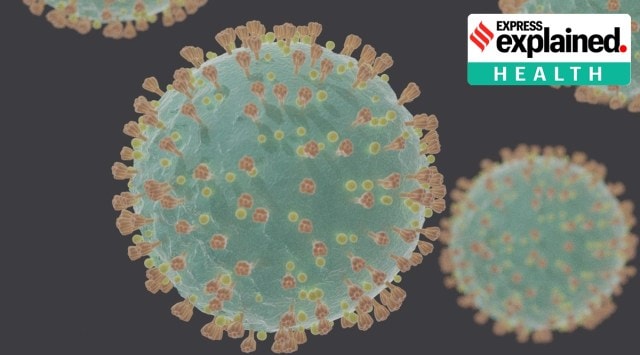- India
- International
New research: A molecule that can help Covid-19 virus evade antibodies
As more and more coronavirus vaccines are rolled out, it is critically important to understand immunity to SARS-CoV-2 and also how the virus evades antibodies.
 When SARS-CoV-2 infects a patient’s lungs it damages blood vessels and causes a rise in the number immune cells. (Source: Wikimedia Commons)
When SARS-CoV-2 infects a patient’s lungs it damages blood vessels and causes a rise in the number immune cells. (Source: Wikimedia Commons)A new study has found that a natural molecule can effectively block the binding of a subset of human antibodies to SARS-CoV-2. The discovery may help explain why some Covid-19 patients can become severely ill despite having high levels of antibodies against the virus, researchers said.
They published their research in the journal Science Advances on Thursday.
Newsletter | Click to get the day’s best explainers in your inbox
Researchers from the Francis Crick Institute, in collaboration with researchers at Imperial College London, Kings College London and UCL (University College London), found that biliverdin and bilirubin — natural molecules present in the body — can suppress the binding of antibodies to the coronavirus spike protein.
As more and more coronavirus vaccines are rolled out, it is critically important to understand immunity to SARS-CoV-2 and also how the virus evades antibodies. However, there are still many unknowns. The ability of the immune system to control the infection, and the quality of the antibody response, are highly variable between individuals.

The researchers discovered that the SARS-CoV-2 spike protein strongly binds to biliverdin, a molecule which was giving these proteins an unusual green colouration. On the other hand, they found, the same natural molecule reduced antibody binding to the spike. They used blood sera and antibodies from people who were previously infected with SARS-CoV-2 and found that biliverdin could suppress the binding of human antibodies to the spike by as much as 30-50%, with some antibodies becoming ineffective at neutralising the virus.
To find out the mechanism at work, the team used cryo-Em and X-ray crystallography to look in detail at the interactions between the spike, the antibodies and biliverdin. They found that biliverdin attaches to the spike N-terminal domain and stabilises it, so that the spike is not able to open up and expose parts of its structure. This means that some antibodies are not able to access their target sites and so cannot bind to and neutralise the virus.
The Crick Institute quoted first author Annachiara Rosa as saying: “When SARS-CoV-2 infects a patient’s lungs it damages blood vessels and causes a rise in the number immune cells. Both of these effects may contribute to increasing the levels of biliverdin and bilirubin in the surrounding tissues. And with more of these molecules available, the virus has more opportunity to hide from certain antibodies. This is a really striking process, as the virus may be benefiting from a side-effect of the damage it has already caused.”
(Source: Francis Crick Institute)
More Explained
Must Read
EXPRESS OPINION
Apr 23: Latest News
- 01
- 02
- 03
- 04
- 05































